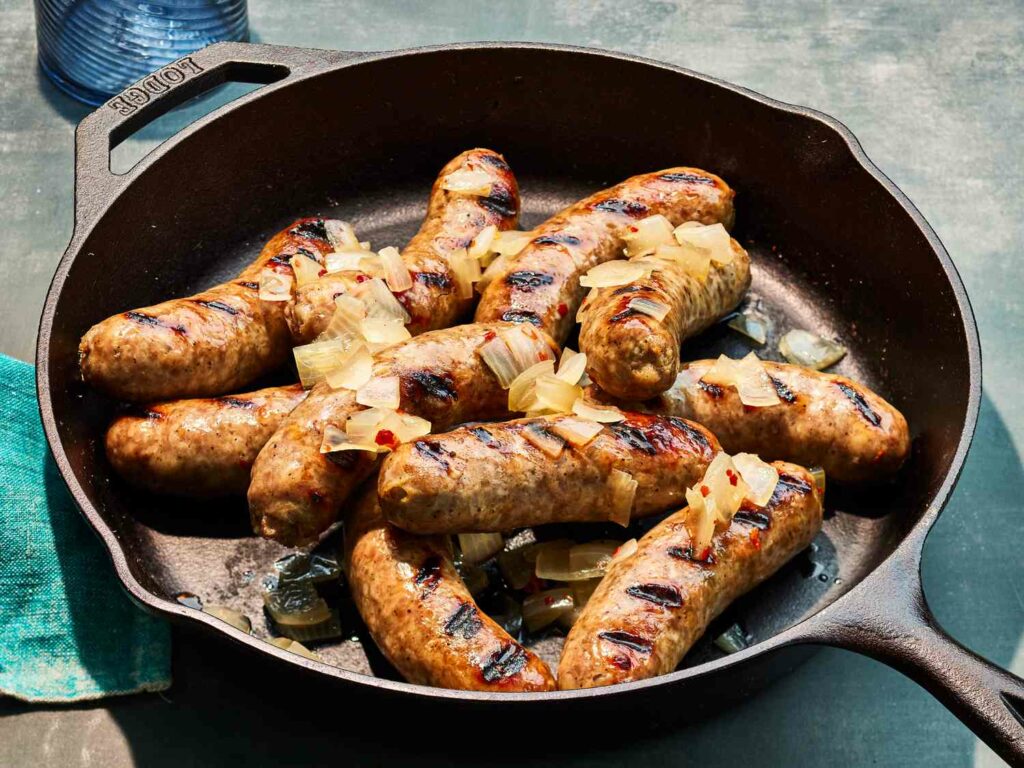Savoring Tradition: Exploring the History and Craftsmanship of Bratwurst

Introduction: In the heart of Bavaria, amid the rolling hills and quaint villages of southern Germany, there exists a culinary tradition that is as rich in history as it is in flavor. Bratwurst, a savory sausage made from finely ground pork, spices, and herbs, has long been a symbol of German cuisine and hospitality. But beyond its delicious taste lies a captivating history and a meticulously crafted recipe that has been cherished for centuries. Join us as we delve into the origins, traditions, and techniques behind this iconic sausage.
Origins of Bratwurst: The origins of bratwurst can be traced back to medieval Germany, where it emerged as a popular dish among butchers and meat artisans. The word “bratwurst” is derived from the Old High German words “brät” (finely chopped meat) and “wurst” (sausage), reflecting the simple yet flavorful nature of the dish.
Originally, bratwurst was made from a mixture of finely ground pork, beef, or veal, seasoned with salt, pepper, and other spices, then stuffed into natural casings and grilled or fried until golden and crispy. Over time, bratwurst evolved into the rich and aromatic sausage that we know today, with each region of Germany adding its own unique twist to the classic recipe.
Ingredients and Preparation: While there are many variations of bratwurst, the classic recipe typically consists of the following ingredients:
- Pork: Pork is the primary ingredient in bratwurst, providing a rich, meaty flavor and a tender texture. The pork is typically ground or minced finely, then mixed with other ingredients to form the sausage filling.
- Spices and Herbs: A blend of spices and herbs such as salt, pepper, nutmeg, mace, marjoram, and caraway seeds are used to season bratwurst, adding depth and complexity to the flavor. The exact spice blend may vary depending on regional preferences and family traditions.
- Natural Casings: Natural casings made from the intestines of pigs or sheep are used to encase the bratwurst filling, giving the sausage its distinctive shape and texture. The casings are carefully cleaned, soaked, and prepared before being filled with the seasoned meat mixture.
- Beer or Milk: Some recipes for bratwurst call for the addition of beer or milk to the meat mixture, which helps to tenderize the meat and add moisture to the sausage. The beer or milk is typically added slowly to the meat mixture until it reaches the desired consistency.
Once all the ingredients are prepared, they are mixed together and stuffed into the natural casings, then twisted or tied into individual links. The bratwurst is then grilled, fried, or simmered until cooked through and golden brown, resulting in a succulent sausage that is bursting with flavor.
Cultural Significance: Bratwurst holds a special place in German culture, serving as a symbol of tradition, community, and celebration. It is often enjoyed at festivals, fairs, and outdoor markets, where it is grilled over an open flame and served with mustard, sauerkraut, and crusty bread.
In addition to its cultural significance, bratwurst is also a popular dish in German restaurants and beer gardens, where it is often served as a main course or as part of a hearty meal. It has even gained popularity outside of Germany, with bratwurst-themed events and festivals held in countries around the world.
Tips and Variations: While traditional bratwurst is made with pork and a blend of spices and herbs, there are many variations of the sausage that incorporate different ingredients and flavors. Some popular variations include:
- Weisswurst: A traditional Bavarian sausage made from finely ground veal and pork, seasoned with parsley, lemon zest, and spices. Weisswurst is typically boiled and served with sweet mustard and pretzels.
- Currywurst: A popular street food in Germany made from grilled or fried bratwurst smothered in a spicy curry ketchup sauce. Currywurst is often served with fries or bread rolls for dipping.
- Thüringer Rostbratwurst: A regional specialty from Thuringia made from coarsely ground pork seasoned with garlic, marjoram, caraway seeds, and spices. Thüringer Rostbratwurst is traditionally grilled over an open flame and served with mustard and bread.
Conclusion: In conclusion, bratwurst is much more than just a sausage—it’s a culinary masterpiece that celebrates the rich heritage and traditions of Germany. From its humble origins as a peasant dish to its status as a celebrated delicacy enjoyed by people around the world, bratwurst continues to captivate and delight food lovers of all ages.
So whether you’re savoring it at a traditional beer garden or trying it for the first time in your own kitchen, one thing is for certain: bratwurst is a timeless classic that never fails to impress. So why not indulge in a taste of Germany’s culinary heritage and experience the magic of bratwurst for yourself? Guten Appetit!




